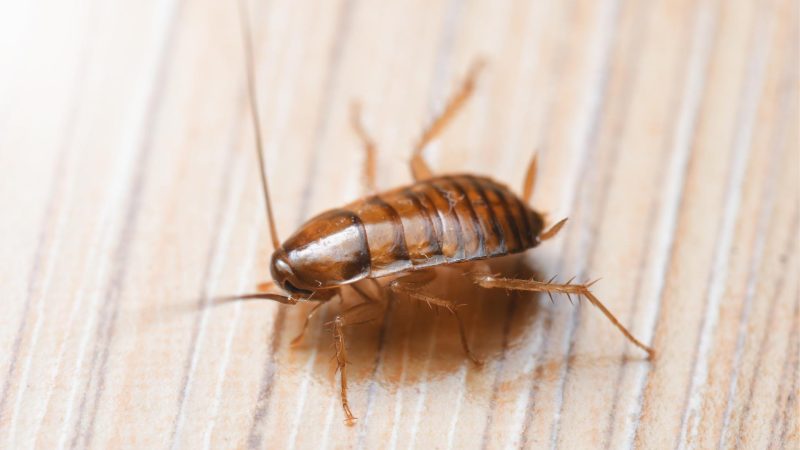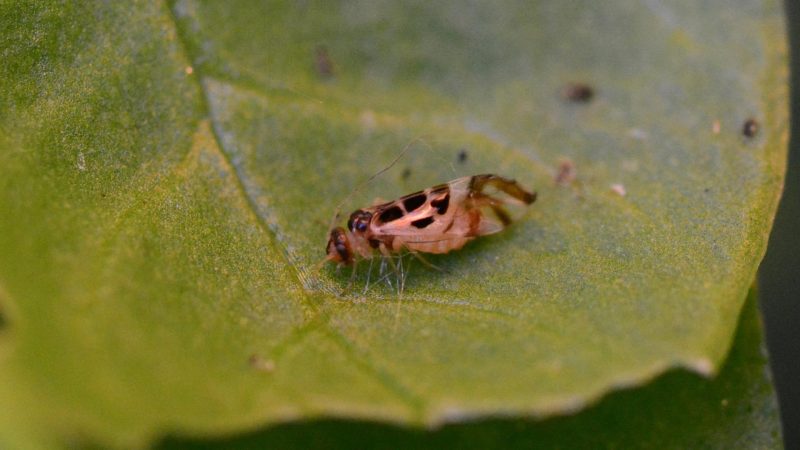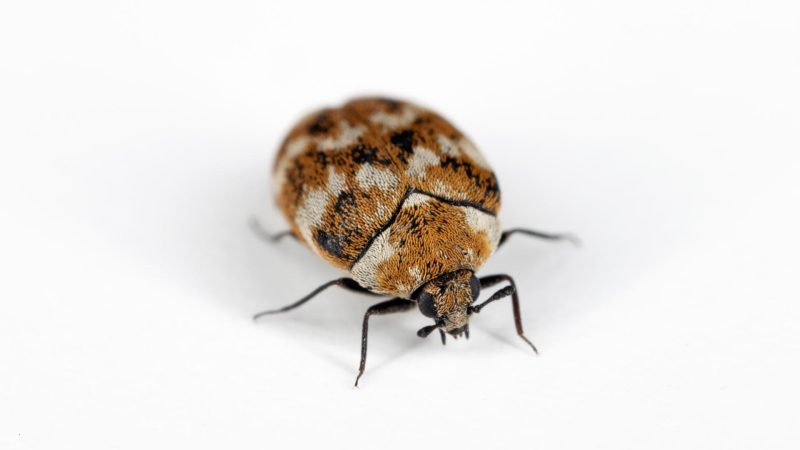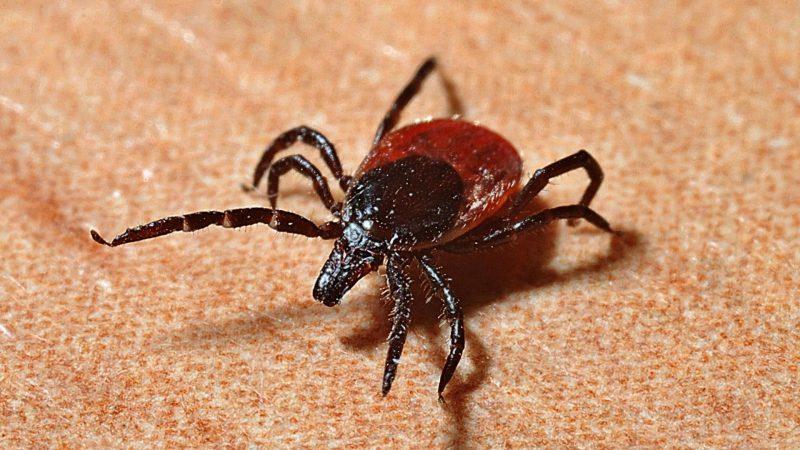If you see a small black bug in your bed, you might immediately think that it is a bed bug. However, there could also be other tiny black bugs in bed but not bed bugs.
But because they are very small, you will find it hard to tell whether they are bed bugs or not, and therefore, eliminating them can be very frustrating.
So, what are the tiny bugs in bed but not bed bugs? There are several types of bugs that look like bed bugs. Among them are baby cockroaches, bat bugs, booklice, carpet beetles, drugstore beetles, fleas, spider beetles, and swallow bugs. Ticks also resemble bed bugs, although they are not classified as bugs.
First of all, there is no such thing as black bed bugs. This is because bed bugs are brown when hungry and will become reddish-brown if recently fed with blood.
In this comprehensive guide, you will learn about the different tiny bugs in bed that are not bed bugs. You will also realize that some of them are not dangerous at all.
8 Tiny Bugs in Bed But Not Bed Bugs
1. Baby Cockroaches

In general, baby cockroaches resemble their adult version but are smaller and have no wings yet.
This is also why they could be mistaken for bed bugs. Also called a nymph, a baby cockroach is usually white immediately after hatching and slowly becomes grayish brown and is already feeding on food and water.
There are at least 69 different species of cockroaches in the US, and the five common ones are the German cockroach, American cockroach, Oriental cockroach, Australian cockroach (brown-banded), and Pennsylvania wood cockroach.
Almost all cockroach species are nocturnal but can still be active during the day.
Cockroaches are generally social insects and usually live in groups, wherein nymphs are usually more abundant than adults.
Almost all adult cockroaches have wings but some of them don’t fly such as the Oriental cockroach. Some species, including the German cockroach, prefer living indoors over outdoors.
Baby cockroaches undergo several molting stages as they become adults, but some of them will have markings on their backs.
Nonetheless, all indoor species can infest homes, contaminate food and kitchen utensils, destroy fabrics, and paper, and leave very unpleasant odors on surfaces they had contact with.
Related: What Do Baby Cockroaches Look Like? | Pictures and Descriptions!
Do Baby Cockroaches Carry Diseases?
Baby cockroaches carry diseases just like adults. Due to their association with garbage and human waste, a cockroach infestation can cause cholera, diarrhea, dysentery, food poisoning, leprosy, plague, and typhoid fever, among others. Their saliva and feces can also cause asthma and skin irritation.
2. Bat Bugs
Both the bat bugs and the bed bugs belong to the infraorder Cimicomorpha in the order Hemiptera. These two true bug species are closely related to each other, so it’s no surprise that they are almost look-alikes.
However, the hairs of bat bugs are thicker and longer. But still, you need a microscope to see their difference.
Just like bed bugs, bat bugs have a short broad head and an oval, flat body, and they also suck blood. But as the name suggests, bat bugs prefer sucking fresh bat blood over human blood.
Nonetheless, they may also feed on other warm-blooded animals and humans if their main source of food is not available.
Bat bugs are commonly found in caves and structures where bats live. They also don’t have wings, so they cannot fly.
But once the bats leave, these tiny bugs crawl and can enter houses through damaged windows, cracks, and crevices, or by crawling down from your chimney or attic, and then entering your bedroom.
Once bat bugs have climbed into your bed, they will hide under your mattress, box springs, and bed frames. Bat bugs are fast crawlers and may bite you while you are sleeping.
These small bugs in bed are mostly active at night, which makes them more difficult to see. In short, bat bugs can also be nuisance pests.
Do Bat Bugs Carry Diseases?
Bat bugs don’t carry diseases, and they don’t transmit viruses and disease-causing pathogens to humans.
But although they rarely bite humans, bat bug bites can cause skin redness, swelling, and intense itching that can last for about a week. If not treated immediately, this can lead to anxiety, stress, and insomnia.
Related: Bat Bugs Information, Habitat and Control
3. Booklice

Booklice look like bed bug nymphs because of their white, translucent body but can also be gray or brown. They also resemble lice but are not considered true lice.
Also called psocids (short for Psocidae), booklice are cousins of barklice, which usually live in tree barks and feed on fungi, pollen, and decaying plants.
In general, psocids are less than 3/16 inches long with soft bodies, slender antennae, and a huge nose called clypeus.
Unlike barklice, booklice don’t have wings and usually live indoors where there is mold and fungi. They can also be found in wet, warm, undisturbed places inside houses, especially during summer.
Booklice got their name from their favorite foods such as paper, books, and glue from bookbindings and wallpapers, as well as other starchy materials.
Aside from houses, these wingless pests may also invade food manufacturing facilities and commercial food storage and will damage the foods that are wet or have molds.
If their main source of food is not available, booklice will also eat animal feed, cereals, grains, dried fruits, flour, and oats. Fortunately, they are not external parasites, and they don’t bite humans and pets.
But when in large numbers, these psocids can be very annoying because of the damage they can do to your home.
Do Booklice Carry Diseases?
Booklice don’t carry diseases and are not harmful to humans and pets. But despite not posing health risks, people can be traumatized once they find these pests on their books and stored food.
Food businesses and restaurant owners may also lose lots of money once their food storage encounters a booklice infestation.
4. Carpet Beetle

Most carpet beetles are black and small bed bugs are never black. As the name implies, carpet beetles live on wool carpets.
These tiny bugs can also be found in items made of fur, feathers, hair, silk, skin, and wool. These materials contain keratin, an important structural fibrous protein that carpet beetle larvae feed on.
There are three types of carpet beetles – varied carpet beetle, furniture carpet beetle, and black carpet beetle. All of them can be mistaken for bed bugs due to their almost similar, small appearance.
Just like bed bugs, carpet beetles also have a flat, oval body, and six long legs, and prefer hiding in dark, secluded places.
Varied carpet beetles are about 1/10 inch long and can be black or have mottled patterns of brown, yellow, orange, and white.
Furniture carpet beetles are slightly bigger than the varied carpet beetles and have rounder bodies. On the other hand, black carpet beetles are 1/8-3/16 inches long and are black or dark brown.
But unlike mature bed bugs, adult carpet beetles can fly and don’t suck human blood. Instead, they feed on pollen and nectar in flowers.
These black beetle bed bugs look alike and are mostly found in gardens, but they can also fly into homes and stay on drapes and window panes. Sometimes, these little bugs land in bed.
Do Carpet Beetles Carry Diseases?
Carpet beetles don’t carry diseases. In fact, they don’t bite humans and don’t pose health risks. But although the adults are seldom found indoors, carpet beetle larvae can cause damage to fabric in every area inside your home, including your bed. Adults lay their eggs indoors, which can cause infestation.
Related: Carpet Beetles in Bed: Do Carpet Beetles Get in Your Bed?
5. Drugstore Beetles

Drugstore beetles are about 1/10 inch (2.5 mm) long and also look like bed bugs but are smaller and have a darker color.
They have a rounded or cylindrical body (instead of flat) that is covered with thick hairs, parallel rows of deep pits on their wing covers, and three enlarged segments at the end of their antennae.
As the name suggests, drugstore beetles are usually found on medicines and drugs in pharmacies.
However, they also feed on almost any kind of food, including bread, cereals, chocolate, ginger, pasta, pepper, pet food, and seeds. Drugstore beetles prefer dry food, but they also eat wood, paper, wool, and hair.
Drugstore beetle larvae are soft, creamy white, and about 3/16 inches long. These white grubs have very short hairs, and a marking on the head ends that forms in a straight line across the front (forehead) just above their mouthparts.
Adults are very attracted to light, and they can fly indoors, especially in libraries and houses.
Also known as bread beetles or biscuit beetles, drugstore beetles can enter homes through small openings.
But sometimes, they are being brought inside through infested purchased food packages, grocery products, and dry animal food. Hence, they may fly or crawl to the bathroom, living room, and bedroom.
Do Drugstore Beetles Carry Diseases?
Drugstore beetles don’t carry diseases and are not known for biting humans. Nonetheless, infested food is no longer recommended for human consumption and should be discarded.
For infested dry pet food, you can try freezing them to kill these nuisance pests. But again, it’s still better to just throw them away.
6. Fleas
Fleas can also be mistaken for bed bugs because they are wingless and reddish-brown.
However, they are no larger than 1/8 inch long and are somehow smaller than bed bugs. Flea larvae are white and about 3/16 inches long.
They feed on flea feces (also called flea dirt), which are mainly composed of undigested blood.
Unlike bed bugs that hide in dark places, fleas are mostly found in animals, including cats and dogs.
These tiny bloodsuckers live, mate, and lay eggs on their host animals but may also attack people and suck human blood. But to produce eggs, females have to suck blood from an animal instead of humans.
Flea bites on animals can cause itching, redness, and skin irritation. Infested animals may experience fur loss, dermatitis and may become anemic.
On the other hand, flea bites on humans with sensitive skin can cause intense itching, and raised, red clustered bumps, which usually occur on the lower part of the legs.
Adult fleas have long hind legs, which they use for jumping from one area to another.
This is why they can easily travel into your skin if your dog or cat has fleas, but you are not aware of them. Fleas may also be present in your bed if you allow your infected pet to sleep in your bedroom without treating them first.
Related: Do Fleas Have Wings? | Information and Facts
Do Fleas Carry Diseases?
Fleas carry diseases but not all of them. Some fleas may be carrying murine typhus, a disease caused by the Rickettsia Typhi bacteria.
Also called flea-borne typhus, fleas can get infected with it if they bite infected animals. Although very rare to happen, fleas can transmit this disease to humans through direct contact.
7. Spider Beetles

As the name suggests, spider beetles resemble small spiders, but they also look like bed bugs.
The three most common types of spider beetles are white-marked spider beetle, smooth spider beetle, and American spider beetle.
Just like bed bugs, these tiny bugs have flat, oval bodies, and they prefer to forage at night.
Whitemarked spider beetles are 2-4.3 mm long with a light brown body, while their wing covers have white hairs.
American spider beetles are 1.5-3.5 mm, and have a black abdomen, while their antennae, head, thorax, and legs are pale yellow. Smooth spider beetles look the same except that they are all-black.
Spider beetles reproduce and feed on a wide variety of foods, fruits, vegetables, and animal material. This includes dead insects, animal skins, chocolate powder, beans, and ginger.
Interestingly, these tiny bugs can also be found in books, bones, textile fabrics, leather, hair, old wood, silk, stuffed birds, and wool.
Belonging to the Ptinidae family, spider beetles are not considered common pests. Nevertheless, their huge population can still cause an infestation in certain situations.
These scavengers can be present in homes, bakeries, museums, grain mills, pantries, warehouses, or any place with rodent or bat droppings.
Do Spider Beetles Carry Diseases?
Spider beetles don’t carry diseases and are not harmful to humans. But because they are nocturnal insects, they can attack your food or damage your priceless artifacts while you are sleeping at night.
These tiny bugs can also be in your bed during low temperatures, especially if you often eat in your bedroom.
8. Swallow Bugs
Swallow bugs also have a very similar appearance to bed bugs since they both belong to the family Cimicidae.
But as the name implies, swallow bugs mostly feed on swallows, a family of small but graceful birds that build mud nests under overhangs of cliffs, homes, buildings, bridges, and other man-made structures.
Just like bed bugs, swallow bugs are also wingless bloodsuckers and have oval, flat bodies. Their color varies from gray to reddish-brown, and they lay eggs on swallow nests.
These parasitic bugs reproduce during spring and summer but are dormant in the winter. They can survive without food for about seven months.
If swallows are not available or when the birds abandon their nests, swallow bugs will patiently crawl into buildings and houses, which can also serve as their shelter.
Once inside, they will hide in dark areas such as floor and wall cracks, cabinets, wardrobes, behind the furniture, and under the beds or mattresses.
Swallow bugs will also bite humans if there are no other sources of food. Their bites have the same effect as bed bug bites.
Fortunately, swallow bugs have a lesser chance of infesting your home as compared to bed bugs. Swallow bug infestation is more likely to occur if swallows will no longer return to their nests.
Do Swallow Bugs Carry Diseases?
Swallow bugs are not known for carrying diseases. Cliff swallows are playing an important role in the transmission of the West Nile virus (WNV), a leading cause of infectious mosquito-borne disease.
But fortunately, a 2010 study suggested that swallow bugs are very unlikely carriers of this virus.
Ticks

For the record, ticks are not classified as bugs or insects but as arachnids because they have eight legs instead of six.
These creepy bloodsuckers are relatives of scorpions, spiders, and mites. Depending on the species, ticks come in various colors and sizes but are so small that they look like bed bugs to the naked eye.
There are around 900 tick species around the world, and they can be categorized into two – hard and soft. Their main difference in behavior is that hard ticks attach themselves firmly to their hosts, while soft ticks don’t.
On the other hand, soft ticks prefer feeding more frequently but only for shorter periods.
So far, the most common tick species found in the US are the American dog tick, Blacklegged tick, Lone star tick, Brown dog tick, and Groundhog tick, also known as the Woodchuck tick.
Dogs are the primary hosts of ticks, but some species may also feed on birds and other mammals such as skunks, squirrels, and raccoons.
Just like bed bugs, ticks don’t have wings, so they cannot fly. They also cannot jump, but they can climb and crawl quickly and attach themselves to their chosen host.
Indoor tick infestations are not common, but some of them can still enter your house and will attack you. Outdoors, ticks bite humans mostly in the woods.
Related: Are Ticks and Bed Bugs Related? | All You Need to Know!
Do Ticks Carry Diseases?
Ticks carry diseases and can transmit them through bites. Blacklegged ticks are primary carriers of Lyme disease and Powassan virus disease.
Other tick-borne diseases that can be transmitted to humans include anaplasmosis, babesiosis, ehrlichiosis, Rocky Mountain spotted fever, and tularemia.
How to Naturally Get Rid Of Tiny Bugs In Bed That Look Like Bed Bugs?
Now that you know that some tiny bugs in bed are not bed bugs, you will have an idea of how to deal with them.
While insecticides can be effective, they contain harsh chemicals that can pose health risks and may damage your belongings. Here are some natural ways to get rid of small bugs in bed:
- Vacuum the infected areas. Just make sure that the suction is as strong as possible. Wash the vacuum bag in hot soapy water before throwing it away.
- Use non-toxic sticky traps such as Catchmaster AA1170 72MAX Pest Trap . Place them in areas where the bugs are coming from.
- Don’t throw away infested carpets and mattresses. Instead, clean them with steam cleaners, such as Ewbank Dynamo Multi-Tool Steam Cleaner .
- Remove their food sources. Check for dead insects or rats and store your food properly. These small bugs in bed will soon migrate to another place.
- Store all foods in bug-proof containers that have tight-fitting lids.
- Block all possible entries such as cracks and crevices and tiny openings on doors and windows.
List of Sources
Choe, D. H. (2020). Carpet Beetles. University of California Agriculture & Natural Resources.
Jacobs. S. (2017). Spider Beetles. PennState Extension.
Ogg, B., Kalisch, J. Bat Bugs and Bat Ticks. University of Nebraska–Lincoln.
Oesterle, P., et al. (2010). Cliff Swallows, Swallow Bugs, and West Nile Virus: An Unlikely Transmission Mechanism. Vector borne and zoonotic diseases (Larchmont, N.Y.).
Hahn, J. (2020). Fleas. University of Minnesota Extension.
- How to Get Rid of Copperheads | Practical Guide - August 27, 2023
- How to Get Rid of Corn Snakes | What Makes Them Aggressive? - August 27, 2023
- How to Get Rid of Alligators | Safety Measures and Removal Methods - July 16, 2023
